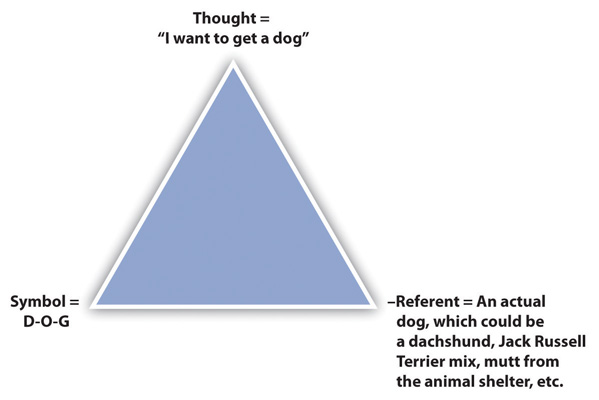1.5 Language and Meaning
Learning Objectives
- Explain how the triangle of meaning describes the symbolic nature of language.
- Distinguish between denotation and connotation.
- Discuss the function of the rules of language.
- Describe the process of language acquisition.
The relationship between language and meaning is not a straightforward one. One reason for this complicated relationship is the limitlessness of modern language systems like English (Crystal, 2005). Language is productive in the sense that there are an infinite number of utterances we can make by connecting existing words in new ways. In addition, there is no limit to a language’s vocabulary, as new words are coined daily. Of course, words aren’t the only things we need to communicate, and although verbal and nonverbal communication are closely related in terms of how we make meaning, nonverbal communication is not productive and limitless. Although we can only make a few hundred physical signs, we have about a million words in the English language. So with all this possibility, how does communication generate meaning?
You’ll recall that “generating meaning” was a central part of the definition of communication we learned earlier. We arrive at meaning through the interaction between our nervous and sensory systems and some stimulus outside of them. It is here, between what the communication models we discussed earlier labeled as encoding and decoding, that meaning is generated as sensory information is interpreted. The indirect and sometimes complicated relationship between language and meaning can lead to confusion, frustration, or even humor. We may even experience a little of all three, when we stop to think about how there are some twenty-five definitions available to tell us the meaning of word meaning! (Crystal, 2005). Because language and symbols are the primary vehicle for our communication, it is important that we not take the components of our verbal communication for granted.
Language Is Symbolic
Our language system is primarily made up of symbols. A symbol is something that stands in for or represents something else. Symbols can be communicated verbally (speaking the word hello), in writing (putting the letters H-E-L-L-O together), or nonverbally (waving your hand back and forth). In any case, the symbols we use stand in for something else, like a physical object or an idea; they do not actually correspond to the thing being referenced in any direct way. Unlike hieroglyphics in ancient Egypt, which often did have a literal relationship between the written symbol and the object being referenced, the symbols used in modern languages look nothing like the object or idea to which they refer.
The symbols we use combine to form language systems or codes. Codes are culturally agreed on and ever-changing systems of symbols that help us organize, understand, and generate meaning (Leeds-Hurwitz, 1993). There are about 6,000 language codes used in the world, and around 40 percent of those (2,400) are only spoken and do not have a written version (Crystal, 2005). Remember that for most of human history the spoken word and nonverbal communication were the primary means of communication. Even languages with a written component didn’t see widespread literacy, or the ability to read and write, until a little over one hundred years ago.
The symbolic nature of our communication is a quality unique to humans. Because the words we use do not have to correspond directly to a “thing” in our “reality,” we can communicate in abstractions. This property of language is called displacement and specifically refers to our ability to talk about events that are removed in space or time from a speaker and situation (Crystal, 2005). Animals do communicate, but in a much simpler way that is only a reaction to stimuli. Further, animal communication is very limited and lacks the productive quality of language that we discussed earlier.

As noted in earlier in this chapter, the earliest human verbal communication was not very symbolic or abstract, as it likely mimicked sounds of animals and nature. Such a simple form of communication persisted for thousands of years, but as later humans turned to settled agriculture and populations grew, things needed to be more distinguishable. More terms (symbols) were needed to accommodate the increasing number of things like tools and ideas like crop rotation that emerged as a result of new knowledge about and experience with farming and animal domestication. There weren’t written symbols during this time, but objects were often used to represent other objects; for example, a farmer might have kept a pebble in a box to represent each chicken he owned. As further advancements made keeping track of objects-representing-objects more difficult, more abstract symbols and later written words were able to stand in for an idea or object. Despite the fact that these transitions occurred many thousands of years ago, we can trace some words that we still use today back to their much more direct and much less abstract origins.
For example, the word calculate comes from the Latin word calculus, which means “pebble.” But what does a pebble have to do with calculations? Pebbles were used, very long ago, to calculate things before we developed verbal or written numbering systems (Hayakawa & Hayakawa, 1990). As noted previously, a farmer may have kept, in a box, one pebble for each of his chickens. Each pebble represented one chicken, meaning that each symbol (the pebble) had a direct correlation to another thing out in the world (its chicken). This system allowed the farmer to keep track of his livestock. He could periodically verify that each pebble had a corresponding chicken. If there was a discrepancy, he would know that a chicken was lost, stolen, or killed. Later, symbols were developed that made accounting a little easier. Instead of keeping track of boxes of pebbles, the farmer could record a symbol like the word five or the numeral 15 that could stand in for five or fifteen pebbles. This demonstrates how our symbols have evolved and how some still carry that ancient history with them, even though we are unaware of it. While this evolution made communication easier in some ways, it also opened up room for misunderstanding, because the relationship between symbols and the objects or ideas they represented became less straightforward. Although the root of calculate means “pebble,” the word calculate today has at least six common definitions.
The Triangle of Meaning
The triangle of meaning is a model of communication that indicates the relationship among a thought, symbol, and referent and highlights the indirect relationship between the symbol and referent (Richards & Ogden, 1923). As you can see in Figure 1.4 “Triangle of Meaning,” the thought is the concept or idea a person references. The symbol is the word that represents the thought, and the referent is the object or idea to which the symbol refers. This model is useful for us as communicators because when we are aware of the indirect relationship between symbols and referents, we are aware of how common misunderstandings occur, as the following example illustrates: Jasper and Abby have been thinking about getting a new dog. So, each of them is having a similar thought. They are each using the same symbol, the word dog, to communicate about their thought. Their referents, however, are different. Jasper is thinking about a small dog like a dachshund, and Abby is thinking about an Australian shepherd. Because the word dog doesn’t refer to one specific object in our reality, it is possible for them to have the same thought, and use the same symbol, but end up in an awkward moment when they get to the shelter and fall in love with their respective referents only to find out the other person didn’t have the same thing in mind.

Being aware of this indirect relationship between symbol and referent, we can try to compensate for it by getting clarification. Some of what we will learn in Chapter 6: “Perception,” about perception checking, can be useful here. Abby might ask Jasper, “What kind of dog do you have in mind?” This question would allow Jasper to describe his referent, which would allow for more shared understanding. If Jasper responds, “Well, I like short-haired dogs. And we need a dog that will work well in an apartment,” then there’s still quite a range of referents. Abby could ask questions for clarification, like “Sounds like you’re saying that a smaller dog might be better. Is that right?” Getting to a place of shared understanding can be difficult, even when we define our symbols and describe our referents.
Definitions
Definitions help us narrow the meaning of particular symbols, which also narrows a symbol’s possible referents. They also provide more words (symbols) for which we must determine a referent. If a concept is abstract and the words used to define it are also abstract, then a definition may be useless. Have you ever been caught in a verbal maze as you look up an unfamiliar word, only to find that the definition contains more unfamiliar words? Although this can be frustrating, definitions do serve a purpose.
Words have denotative and connotative meanings. Denotation refers to definitions that are accepted by the language group as a whole, or the dictionary definition of a word. For example, the denotation of the word cowboy is a man who takes care of cattle. Another denotation is a reckless and/or independent person. A more abstract word, like change, would be more difficult to understand due to the multiple denotations. Because both cowboy and change have multiple meanings, they are considered polysemic words. Monosemic words have only one use in a language, which makes their denotation more straightforward. Specialized academic or scientific words, like monosemic, are often monosemic, but there are fewer commonly used monosemic words, for example, handkerchief. As you might guess based on our discussion of the complexity of language so far, monosemic words are far outnumbered by polysemic words.
Connotation refers to definitions that are based on emotion- or experience-based associations people have with a word. To go back to our previous words, change can have positive or negative connotations depending on a person’s experiences. A person who just ended a long-term relationship may think of change as good or bad depending on what he or she thought about his or her former partner. Even monosemic words like handkerchief that only have one denotation can have multiple connotations. A handkerchief can conjure up thoughts of dainty Southern belles or disgusting snot-rags. A polysemic word like cowboy has many connotations, and philosophers of language have explored how connotations extend beyond one or two experiential or emotional meanings of a word to constitute cultural myths (Barthes, 1972). Cowboy, for example, connects to the frontier and the western history of the United States, which has mythologies associated with it that help shape the narrative of the nation. The Marlboro Man is an enduring advertising icon that draws on connotations of the cowboy to attract customers. While people who grew up with cattle or have family who ranch may have a very specific connotation of the word cowboy based on personal experience, other people’s connotations may be more influenced by popular cultural symbolism like that seen in westerns.
Language Is Learned
As we just learned, the relationship between the symbols that make up our language and their referents is arbitrary, which means they have no meaning until we assign it to them. To effectively use a language system, we have to learn, over time, which symbols go with which referents, because we can’t just tell by looking at the symbol. Like most people, you probably learned what the word apple meant by looking at the letters A-P-P-L-E and a picture of an apple and having a teacher or caregiver help you sound out the letters until you said the whole word. Over time, we associated that combination of letters with the picture of the red delicious apple and no longer had to sound each letter out. This is a deliberate process that may seem slow in the moment, but as we will see next, our ability to acquire language is actually quite astounding. We didn’t just learn individual words and their meanings, though; we also learned rules of grammar that help us put those words into meaningful sentences.

The Rules of Language
Any language system has to have rules to make it learnable and usable. Grammar refers to the rules that govern how words are used to make phrases and sentences. Someone would likely know what you mean by the question “Where’s the remote control?” But “The control remote where’s?” is likely to be unintelligible or at least confusing (Crystal, 2005). Knowing the rules of grammar is important to be able to write and speak to be understood, but knowing these rules isn’t enough to make you an effective communicator. As we will learn later, creativity and play also have a role in effective verbal communication. Even though teachers have long enforced the idea that there are right and wrong ways to write and say words, there really isn’t anything inherently right or wrong about the individual choices we make in our language use. Rather, it is our collective agreement that gives power to the rules that govern language.
Some linguists have viewed the rules of language as fairly rigid and limiting in terms of the possible meanings that we can derive from words and sentences created from within that system (de Saussure, 1974). Others have viewed these rules as more open and flexible, allowing a person to make choices to determine meaning (Eco, 1976). Still others have claimed that there is no real meaning and that possibilities for meaning are limitless (Derrida, 1978). For our purposes in this chapter, we will take the middle perspective, which allows for the possibility of individual choice but still acknowledges that there is a system of rules and logic that guides our decision-making.
Looking back to our discussion of connotation, we can see how individuals play a role in how meaning and language are related, since we each bring our own emotional and experiential associations with a word that are often more meaningful than a dictionary definition. In addition, we have quite a bit of room for creativity, play, and resistance with the symbols we use. Have you ever had a secret code with a friend that only you knew? This can allow you to use a code word in a public place to get meaning across to the other person who is “in the know” without anyone else understanding the message. The fact that you can take a word, give it another meaning, have someone else agree on that meaning, and then use the word in your own fashion clearly shows that meaning is in people rather than words. As we will learn later, many slang words developed because people wanted a covert way to talk about certain topics like drugs or sex without outsiders catching on.
Language Acquisition
Language acquisition refers to the process by which we learn to understand, produce, and use words to communicate within a given language group. The way we acquire language is affected by many factors. We know that learning a language is not just about learning words. We have to learn how to correctly connect the words to what they mean in a given context and be able to order the words in such a way, within the rules of grammar for the language code we are using, that other people will be able to understand us (Hayakawa & Hayakawa, 1990). As if that didn’t seem like enough to learn, we also have to learn various conversational patterns that we regularly but often unconsciously follow to make our interactions smooth and successful. A brief overview of language acquisition from birth to adulthood offers us a look at the amazing and still somewhat mysterious relationships between our brain, eyes, ears, voice, and other physiological elements (Crystal, 2005). In terms of language acquisition, there is actually a great deal of variation between individuals due to physical and contextual differences, but this overview presumes “typical development.”
Much is being taken in during the first year of life as brain development accelerates, and senses are focused and tuned. Primary caregivers are driven, almost instinctively, to begin instilling conversational abilities in babies from birth. As just about anyone who has spent time around a baby during this phase of rapid development can attest, there is a compulsion to interact with the child, which is usually entertaining for adult and baby. This compulsion isn’t random or accidental, and we would be wrong to assume that our communication is useless or just for fun. We would also be wrong to assume that language acquisition doesn’t begin until a baby says his or her first words. By the time this happens, babies have learned much, through observation and practice, about our verbal communication and interaction patterns. These key developments include the following:
- 2–4 months. Babies can respond to different tones of voice (angry, soothing, or playful).
- 6 months. Babies can associate some words, like bye-bye, with a corresponding behavior, and they begin “babbling,” which is actually practice for more intelligible speech to come.
- 8–10 months. Babies learn that pointing can attract or direct attention, and they begin to follow adult conversations, shifting eye contact from one speaker to the next.
- 1 year. Babies recognize some individual words (people’s names, no) and basic rituals of verbal interaction such as question-pause-answer and various greetings. Shortly before or after this time, babies begin to use “melodic utterances,” echoing the variety in pitch and tone in various verbal interactions such as questioning, greeting, or wanting.

Language acquisition after the age of two seems sluggish compared to the pace of development during the first year or so. By the end of the first year, babies have learned most of the basic phonetic components necessary for speech. The second year represents a time of intense practice—of verbal trial and error. From three to five, we continue to develop our pronunciation ability, which develops enough by our teens to allow us to engage in everyday communication. Of course, our expressive repertoire, including ways of speaking and the vocabulary we use, continues to develop. A person’s life and career choices determine to a large degree how much further development occurs. But the language abilities we have acquired can decrease or disappear as a result of disease or trauma. Additionally, if such things occur early in life, or before birth, the process of language acquisition can be quite different. Barriers to speech and language acquisition are common and are the domain of a related but distinct field of study often housed in departments of communication sciences and disorders. The “Getting Real” box featured discusses this field of study and related careers.
Key Takeaways
- The triangle of meaning is a model of communication that indicates the relationship among a thought, symbol, and referent, and highlights the indirect relationship between the symbol and the referent. The model explains how for any given symbol there can be many different referents, which can lead to misunderstanding.
- Denotation refers to the agreed on or dictionary definition of a word. Connotation refers to definitions that are based on emotion- or experience-based associations people have with a word.
- The rules of language help make it learnable and usable. Although the rules limit some of the uses of language, they still allow for the possibility of creativity and play.
- Language acquisition refers to the process by which we learn to understand, produce, and use words to communicate within a given language group. This process happens at an amazing speed during the first two years of life, and we attain all the linguistic information we need to participate in everyday conversations, assuming normal development, by our early teens.
1.5 Crossword Activity
1.5 Drag the Words
1.5 Question Set
Exercises
- Trace the history of a word (its etymology) like the word calculate earlier in the chapter. Discuss how the meaning of the word (the symbol) has changed as it has gotten further from its original meaning. Two interesting words to trace are hazard and phony.
- Apply the triangle of meaning to a recent message exchange you had in which differing referents led to misunderstanding. What could you have done to help prevent or correct the misunderstanding?
- Think of some words that have strong connotations for you. How does your connotation differ from the denotation? How might your connotation differ from another person’s?
References
Barthes, R., Mythologies (New York, NY: Hill and Wang, 1972).
Crystal, D., How Language Works: How Babies Babble, Words Change Meaning, and Languages Live or Die (Woodstock, NY: Overlook Press, 2005), 8–9.
de Saussure, F., Course in General Linguistics, trans. Wade Baskin (London: Fontana/Collins, 1974).
Derrida, J., Writing and Difference, trans. Alan Bass (London: Routledge, 1978).
Eco, U., A Theory of Semiotics (Bloomington, IN: Indiana University Press, 1976).
Hayakawa, S. I. and Alan R. Hayakawa, Language in Thought and Action, 5th ed. (San Diego, CA: Harcourt Brace, 1990), 87.
Leeds-Hurwitz, W., Semiotics and Communication: Signs, Codes, Cultures (Hillsdale, NJ: Lawrence Erlbaum Associates, 1993), 53.
Richards, I. A. and Charles K. Ogden, The Meaning of Meaning (London: Kegan, Paul, Trench, Tubner, 1923).
- American Speech-Language-Hearing Association, accessed June 7, 2012, http://www.asha.org/careers/professions/default-overview.htm. ↵

